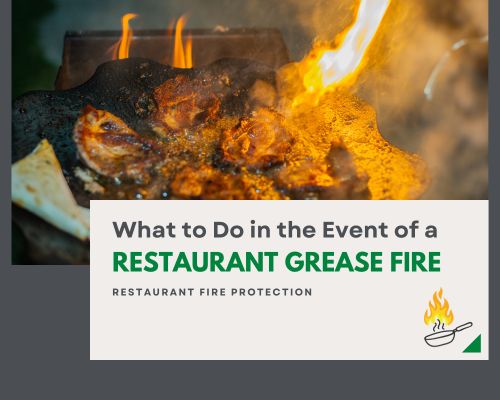
As a restaurant owner, it’s imperative to take fire safety seriously. This year’s theme for Fire Prevention Week is cooking safety — and it’s no wonder, according to the most recent report by the NFPA, over 7,000 structure fires in eating and drinking establishments were reported each year during the study resulting in death, injury and millions of dollars in property damage. In this blog, we will focus on a common cause of these fires: grease or cooking fires.
GREASE OR COOKING FIRES
Grease or cooking fires are a prevalent hazard that occurs when cooking oil reaches excessive temperatures, typically during busy periods and when left unattended. The oil will start to boil and then smoke, eventually catching on fire. These small fires can result in burns or spread to become larger structural fires and pose a significant risk. It is essential to equip employees with knowledge on how to promptly extinguish these fires to prevent them from escalating.
HOW TO EXTINGUISH RESTAURANT COOKING FIRES
- Pull the fire suppression system pull station. This will activate the fire suppression system, close gas valves, and shut down electrical power to appliances. It will also cut off the fuel source to help prevent reignition. In addition, the wet chemical agent that is released will help cool the hot grease to below its reignition temperature.
- Use a portable wet chemical fire extinguisher as a backup. If for any reason the fire was not extinguished by the fire suppression system, make sure a wet chemical fire extinguisher is easily accessible and that your employees are trained in how to use it.
Always use the fire suppression system BEFORE using an extinguisher.
It’s a common misperception for restaurant owners and employees to believe that using a fire extinguisher before activating the fire suppression system is a good idea. They often think doing so will alleviate hassles such as cleanup and resetting the system. However, it is always best to make putting out the fire your number one priority. The most effective method available is the fire suppression system. Triggering the system and cutting off the fuel source is key to making sure the fire won’t grow and that it can be easily extinguished. If you are not able to completely extinguish a fire by using only the extinguisher, you will run the risk of the grease becoming hotter and more susceptible to reignition.
If you have any questions on how to best equip your commercial kitchen in order to be prepared in the event of a fire, please contact a fire expert at Summit Fire Protection, a full-service and comprehensive fire and life safety solutions provider.

